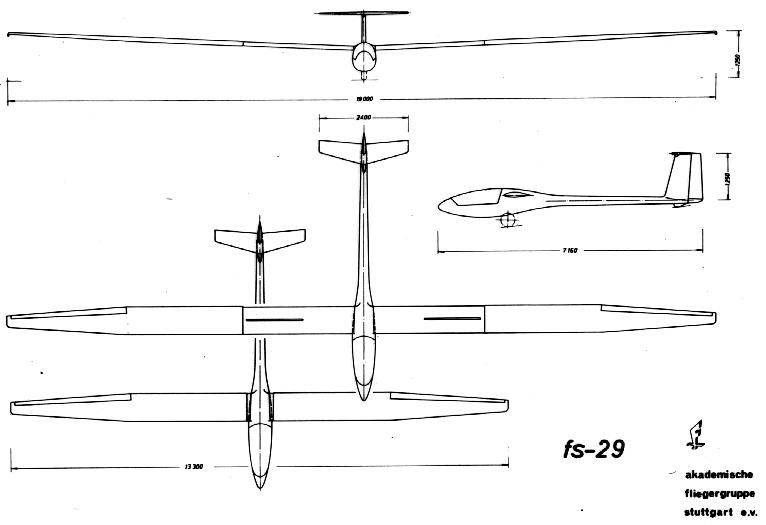Telescoping Wing
The fs29 is as of yet the only sailplane in the world which can alter its wingspan in flight. Since one flies in different speed ranges when flying long distances, it’s worth it to find a ay to optimize the geometry of the wings to these speeds. There are two possible ways to do this: a change of the camber (via flaps for example) or of the wingspan. Both options were weighed against each other at the Akaflieg. The advantages of a telescoping wing include:
- a larger degree of wing area variation
- a higher aspect ratio during low speed flight, resulting in lower induced drag
- a rigid airfoil with a pronounced but narrow laminar drag bucket can always be flown in the optimal region
- less construction work required
These, specifically concerning the average cross-country flight speed, proved to be slightly superior to flaps.
The variable wingspan is made possible by the fact that the outer wings can slide over the inner wings. A toothed belt located spanwise in the inner wing controls the extension and retraction of the outer wing via a pushrod. This belt is powered by a torsion drive in the fuselage. A freewheel gearbox converts the pilot’s pumping motion into a rotary one. To make the wings stiff enough, their spars and skin are made out of CRP. The Akaflieg Braunschweig was of great help here thanks to their experience with the SB 10, the first airplane to be made of carbon fiber. Tests in wind tunnels showed that the outer wings don’t have an adverse effect on aerodynamics if their thickness isn’t larger than 3mm.
Extensive research based on wind tunnel models were done. A shoulder wing configuration was chosen. Compared to the fs25, it had a more rounded nose and a less constricted fuselage. The tail spar is made of aluminium tubes riveted to a steel frame. The tail is from a Schempp-Hirth Nimbus II.
The fs29 was proudly displayed during the ILA International Airshow 1996 in Berlin, allong with the SB 10 and SB 13. In the summer of 1997, it was damaged in a crash, although this was later repaired. Currently, the fs29 resides in the German Museum in Munich.
Specifications
| Construction | 1972 – 1975 |
| First flight | 15 June 1975 |
| Construction method | Inner wing: Spar: CRP-Rovings Skin, Webs: GRP-Foam-Sandwich Outer wing: Rectangular section: pure CRP-Skin Trapezoid section: GRP-Foam-Sandwich Tail spar: Aluminium |
| Wingspan | 13,3 – 19 m |
| Wing area | 8,56 – 12,65 m² |
| Aspect ratio | 20,67 – 28,54 |
| Profile | Rectangular section: FX 73 -170 Trapezoid section: FX 73 – K – 170/22, ß=0° |
| Dihedral angle | 2,5° |
| Wing sweep | 0° (t/4) |
| Wing taper | 0,4 |
| Aileron area | 0,376 m² |
| Tailplane area | 1,03 m² |
| Vertical stabilizer area | 1,11 m² |
| Length | 7,16 m |
| Height | 0,78 m |
| Empty weight | 357 kg |
| MTOW | 450 kg |


